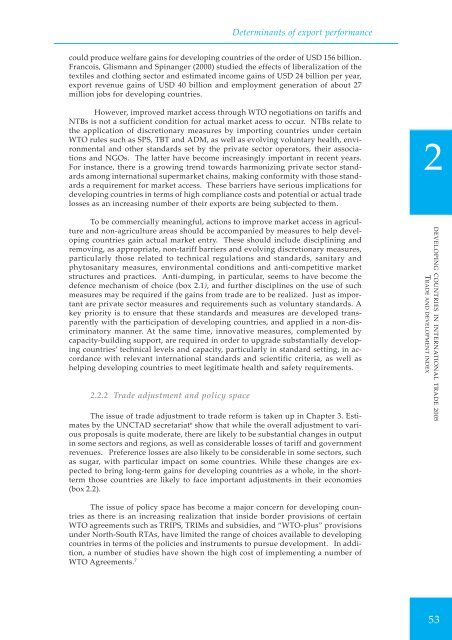Determinants of Export Performance - unctad
Determinants of Export Performance - unctad
Determinants of Export Performance - unctad
You also want an ePaper? Increase the reach of your titles
YUMPU automatically turns print PDFs into web optimized ePapers that Google loves.
<strong>Determinants</strong> <strong>of</strong> export performance<br />
could produce welfare gains for developing countries <strong>of</strong> the order <strong>of</strong> USD 156 billion.<br />
Francois, Glismann and Spinanger (2000) studied the effects <strong>of</strong> liberalization <strong>of</strong> the<br />
textiles and clothing sector and estimated income gains <strong>of</strong> USD 24 billion per year,<br />
export revenue gains <strong>of</strong> USD 40 billion and employment generation <strong>of</strong> about 27<br />
million jobs for developing countries.<br />
However, improved market access through WTO negotiations on tariffs and<br />
NTBs is not a sufficient condition for actual market acess to occur. NTBs relate to<br />
the application <strong>of</strong> discretionary measures by importing countries under certain<br />
WTO rules such as SPS, TBT and ADM, as well as evolving voluntary health, environmental<br />
and other standards set by the private sector operators, their associations<br />
and NGOs. The latter have become increasingly important in recent years.<br />
For instance, there is a growing trend towards harmonizing private sector standards<br />
among international supermarket chains, making conformity with those standards<br />
a requirement for market access. These barriers have serious implications for<br />
developing countries in terms <strong>of</strong> high compliance costs and potential or actual trade<br />
losses as an increasing number <strong>of</strong> their exports are being subjected to them.<br />
To be commercially meaningful, actions to improve market access in agriculture<br />
and non-agriculture areas should be accompanied by measures to help developing<br />
countries gain actual market entry. These should include disciplining and<br />
removing, as appropriate, non-tariff barriers and evolving discretionary measures,<br />
particularly those related to technical regulations and standards, sanitary and<br />
phytosanitary measures, environmental conditions and anti-competitive market<br />
structures and practices. Anti-dumping, in particular, seems to have become the<br />
defence mechanism <strong>of</strong> choice (box 2.1), and further disciplines on the use <strong>of</strong> such<br />
measures may be required if the gains from trade are to be realized. Just as important<br />
are private sector measures and requirements such as voluntary standards. A<br />
key priority is to ensure that these standards and measures are developed transparently<br />
with the participation <strong>of</strong> developing countries, and applied in a non-discriminatory<br />
manner. At the same time, innovative measures, complemented by<br />
capacity-building support, are required in order to upgrade substantially developing<br />
countries’ technical levels and capacity, particularly in standard setting, in accordance<br />
with relevant international standards and scientific criteria, as well as<br />
helping developing countries to meet legitimate health and safety requirements.<br />
2.2.2 Trade adjustment and policy space<br />
The issue <strong>of</strong> trade adjustment to trade reform is taken up in Chapter 3. Estimates<br />
by the UNCTAD secretariat 6 show that while the overall adjustment to various<br />
proposals is quite moderate, there are likely to be substantial changes in output<br />
in some sectors and regions, as well as considerable losses <strong>of</strong> tariff and government<br />
revenues. Preference losses are also likely to be considerable in some sectors, such<br />
as sugar, with particular impact on some countries. While these changes are expected<br />
to bring long-term gains for developing countries as a whole, in the shortterm<br />
those countries are likely to face important adjustments in their economies<br />
(box 2.2).<br />
The issue <strong>of</strong> policy space has become a major concern for developing countries<br />
as there is an increasing realization that inside border provisions <strong>of</strong> certain<br />
WTO agreements such as TRIPS, TRIMs and subsidies, and “WTO-plus” provisions<br />
under North-South RTAs, have limited the range <strong>of</strong> choices available to developing<br />
countries in terms <strong>of</strong> the policies and instruments to pursue development. In addition,<br />
a number <strong>of</strong> studies have shown the high cost <strong>of</strong> implementing a number <strong>of</strong><br />
WTO Agreements. 7<br />
2<br />
DEVELOPING COUNTRIES IN INTERNATIONAL TRADE 2005<br />
TRADE AND DEVELOPMENT INDEX<br />
53

















